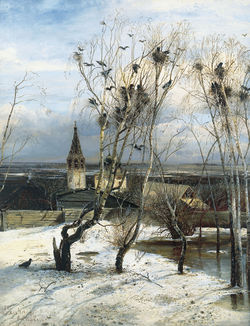Rook (bird)
| Rook | |
|---|---|
 |
|
| Conservation status | |
| Scientific classification | |
| Kingdom: | Animalia |
| Phylum: | Chordata |
| Class: | Aves |
| Order: | Passeriformes |
| Family: | Corvidae |
| Genus: | Corvus |
| Species: | C. frugilegus |
| Binomial name | |
| Corvus frugilegus Linnaeus, 1758 |
|
| Rook range | |
The Rook (Corvus frugilegus) is a member of the Corvidae family in the passerine order of birds. Named by Carl Linnaeus in 1758,[2] the species name frugilegus is Latin for "food-gathering".
This species is similar in size (45–47 cm in length) to or slightly smaller than the Carrion Crow with black feathers often showing a blue or bluish-purple sheen in bright sunlight. The feathers on the head, neck and shoulders are particularly dense and silky. The legs and feet are generally black and the bill grey-black.
Rooks are distinguished from similar members of the crow family by the bare grey-white skin around the base of the adult's bill in front of the eyes. The feathering around the legs also look shaggier and laxer than the congeneric Carrion Crow. The juvenile is superficially more similar to the Crow because it lacks the bare patch at the base of the bill, but it loses the facial feathers after about six months. Collective nouns for rooks include building, parliament, clamour and storytelling.[3][4]
Contents |
Distribution and habitat
Though resident in Great Britain, Ireland and much of north and central Europe, vagrant to Iceland and northern Scandinavia, it also occurs as an eastern race in Asia where it differs in being very slightly smaller on average, and having a somewhat more fully feathered face. In the north of its range the species has a tendency to move south during autumn though more southern populations are apt to range sporadically also. The species has been introduced to New Zealand, with several hundred birds being released there from 1862 to 1874, though today their range is very localised.[5] There the species is an agricultural pest and it is being eradicated.
Behaviour
Diet
Food is predominantly earthworms and insect larvae, which the bird finds by probing the ground with its strong bill. It also eats cultivated cereal grain, smaller amounts of fruit, small mammals, acorns, small birds, their eggs and young and carrion. In urban sites, human food scraps are taken from rubbish dumps and streets, usually in the early hours when it is relatively quiet. It has also been seen along the seashore, feeding on insects, crustaceans and suitable food flotsam.
Nesting
Nesting is always colonial, usually in the very tops of the trees. Branches and twigs are broken off trees (very rarely picked up off the ground), though as many are likely to be stolen from nearby nests as are collected from trees. Eggs are usually 3–5 in number, can appear by the end of February or early March and are incubated for 16–18 days. Both adults feed the young, which are fledged by the 32nd or 33rd day.
In autumn, the young birds of the summer collect into large flocks together with unpaired birds of previous seasons, often in company with Jackdaws. It is during the autumn that spectacular aerial displays can be seen by adult birds that seem to delight in the autumn gales.
Voice
The call is usually described as "kaah" – it is similar to that of the Carrion Crow, but usually rather flatter in tone. It is given both in flight and while perched, when the bird fans its tail and bows on each caw. Calls in flight are usually given singly, in contrast to the Carrion Crow's which are in groups of three or four. Solitary birds often "sing" apparently to themselves uttering strange clicks, wheezes and almost human-like notes.

Intelligence
In captivity, when confronted with problems, rooks have recently been documented as one of multiple species of bird capable of tool use to obtain a goal. They learned that if they push a stone off a ledge into a tube, they will get food. The rooks even quickly discovered they could go get a stone and carry it to the tube if no stone was there already. They also used sticks, wire and even figured out how to bend a wire into a hook to reach an item.[7] Rooks are as clever at making and using simple tools with their beaks as chimpanzees are with their hands.[8]
In an experiment, a rook was placed near a tube of water, with a worm floating on top of the water, and some rocks next to the tube. The water level was too low for the rook to reach the worm. The rook placed rocks into the tube until the water level was high enough for the rook to reach the worm.[9]
Culture and mythology
Like many other members of the Corvidae family, the rook features prominently in folklore. Traditionally, rooks are said to be able to forecast weather and to sense the approach of death. If a rookery — the colonial nesting area of rooks — were abandoned, it was said to bring bad fortune for the family that owned the land. One famous depiction of empty rooks' nests is in David Copperfield by Charles Dickens, where the title character grows up in the fictitious Blunderstone Rookery where he subsequently suffers the tragic death of his mother. Another folk-tale holds that rooks are responsible for escorting the souls of the virtuous dead to heaven.
References
- ↑ BirdLife International (2009) Corvus frugilegus In: IUCN 2009. IUCN Red List of Threatened Species. Version 2009.2. www.iucnredlist.org Retrieved on August 11, 2010.
- ↑ Linnaeus, C. (1758) (in Latin). Systema naturae per regna tria naturae, secundum classes, ordines, genera, species, cum characteribus, differentiis, synonymis, locis. Tomus I. Editio decima, reformata.. Holmiae: Laurentii Salvii. pp. 824. http://dz1.gdz-cms.de/index.php?id=img&no_cache=1&IDDOC=265100.
- ↑ "Collective Nouns for Birds". Palomar Audubon Society. http://palomaraudubon.org/collective.html. Retrieved August 11, 2010.
- ↑ "Collective Nouns for Birds". New Zealand Birds. http://www.nzbirds.com/more/nounsr.html. Retrieved August 11, 2010.
- ↑ Barrie Heather & Hugh Robertson (2005). The Field Guide to the Birds of New Zealand. Penguin Group. ISBN 978-0143020400.
- ↑ G. Debout (2003). "Le corbeau freux (Corvus frugilegus) nicheur en Normandie: recensement 1999 & 2000" (in French). Cormoran 13: 115–121.
- ↑ Rebecca Morelle (May 26, 2009). "Rooks reveal remarkable tool-use". BBC News. http://news.bbc.co.uk/2/hi/science/nature/8059688.stm. Retrieved May 22, 2010.
- ↑ "Study finds rooks as clever as chimpanzees". United Press International. May 26, 2009. http://www.upi.com/Science_News/2009/05/26/Study-finds-rooks-as-clever-as-chimpanzees/UPI-34471243349916.
- ↑ Sarah Bloch (August 7, 2009). "Video: Aesop's Fable - or fact? Meet the world's cleverest bird". Times Online. http://www.timesonline.co.uk/tol/news/uk/science/article6753086.ece.
- Handbook of the Birds of Europe, the Middle East, and North Africa: The Birds of the Western Palearctic Volume VIII: Crows to Finches Chief Editor: the late Stanley Cramp, Edited by C. M. Perrins ISBN 0-19-854679-3
- Crows and Jays by Madge and Burn, ISBN 0-7136-3999-7
External links
 Data related to Corvus frugilegus at Wikispecies
Data related to Corvus frugilegus at Wikispecies Chisholm, Hugh, ed (1911). "rook". Encyclopædia Britannica (Eleventh ed.). Cambridge University Press.
Chisholm, Hugh, ed (1911). "rook". Encyclopædia Britannica (Eleventh ed.). Cambridge University Press.- Rook videos, photos & sounds on the Internet Bird Collection
- "Rooks calling" (WAV). http://www.scricciolo.com/eurosongs/Corvus.frugilegus.wav.
|
||||||||||||||||||||||||||||||||||||||||||||||||||||||||||||||||||||||||||||||||||||||||||||||||||||||||||||||||||
|
|||||||||||||||||||
